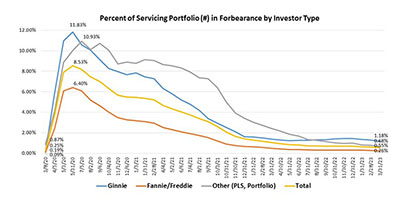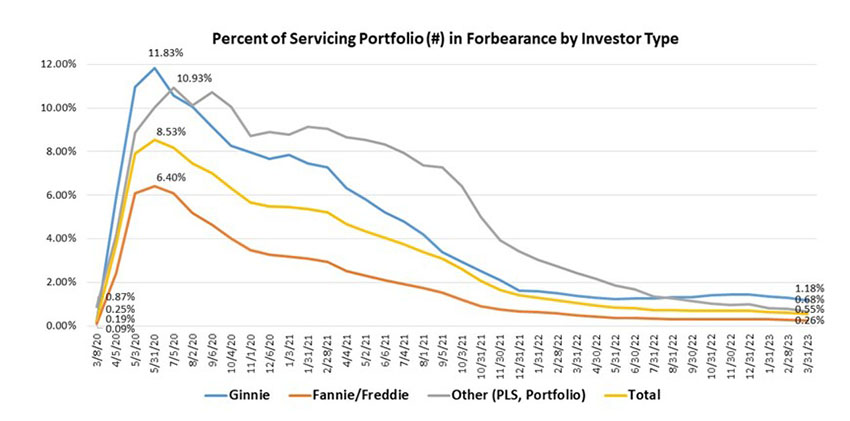
MBA: Share of Mortgage Loans in Forbearance Decreases to 0.55%

The Mortgage Bankers Association’s monthly Loan Monitoring Survey reported loans in forbearance decreased by 5 basis points to 0.55% of servicers’ portfolio volume in March from 0.60% in February.
MBA estimates 275,000 homeowners remain in forbearance plans. Mortgage servicers have provided forbearance to 7.8 million borrowers since March 2020.
MBA reported the share of Fannie Mae and Freddie Mac loans in forbearance decreased by 2 basis points in March to 0.26%. Ginnie Mae loans in forbearance decreased by 10 basis points to 1.18%; the forbearance share for portfolio loans and private-label securities decreased by 10 basis points to 0.68%.
“As the COVID-19 national emergency draws to a close, the number of loans in forbearance continues to drop,” said Marina Walsh, CMB, MBA Vice President of Industry Analysis. “Mortgage performance remains strong with the percentage of borrowers who were current on their mortgage payments and post-forbearance workouts increasing in March.”

Walsh noted the MBA forecast still calls for a recession in 2023, which may change current performance levels. “But credit quality is generally good and many borrowers facing financial hardship can now access enhanced loss mitigation options that resulted from successes of pandemic-related policies.”
Key Findings of the MBA Loan Monitoring Survey – March 1-31
- Total loans in forbearance decreased by 5 basis points in March 2023 relative to February 2023: from 0.60% to 0.55%.
- By investor type, the share of Ginnie Mae loans in forbearance decreased relative to the prior month: from 1.28% to 1.18%.The share of Fannie Mae and Freddie Mac loans in forbearance decreased from 0.28% to 0.26%.
- The share of other loans (e.g., portfolio and PLS loans) in forbearance decreased from 0.78% to 0.68%.
- Loans in forbearance as a share of servicing portfolio volume (#) as of March 31:
- Total: 0.55% (previous month: 0.60%)Independent Mortgage Banks (IMBs): 0.74% (previous month: 0.81%)
- Depositories: 0.36% (previous month: 0.40%)
- By stage, 33.8% of total loans in forbearance are in the initial forbearance plan stage, while 52.9% are in a forbearance extension. The remaining 13.3% are forbearance re-entries, including re-entries with extensions.
- Of the cumulative forbearance exits for the period from June 1, 2020, through March 31, 2023, at the time of forbearance exit:
- 29.6% resulted in a loan deferral/partial claim.
- 18.0% represented borrowers who continued to make their monthly payments during their forbearance period.
- 17.7% represented borrowers who did not make all of their monthly payments and exited forbearance without a loss mitigation plan in place yet.
- 16.1% resulted in a loan modification or trial loan modification.
- 10.9% resulted in reinstatements, in which past-due amounts are paid back when exiting forbearance.
- 6.5% resulted in loans paid off through either a refinance or by selling the home.
- The remaining 1.2% resulted in repayment plans, short sales, deed-in-lieus or other reasons.
- Total loans serviced that were current (not delinquent or in foreclosure) as a percent of servicing portfolio volume (#) increased to 96.35% in March from 95.76% in February (on a non-seasonally adjusted basis).
- States with the highest share of loans current as a percent of servicing portfolio: Washington, Idaho, Colorado, Utah and California.
- States with the lowest share of loans current as a percent of servicing portfolio: Louisiana, Mississippi, New York, Oklahoma and West Virginia.
- Total completed loan workouts from 2020 and onward (repayment plans, loan deferrals/partial claims, loan modifications) that were current as a percent of total completed workouts increased to 76.70% in March from 76.00% the previous month.
MBA’s monthly Loan Monitoring Survey (replaced MBA’s Weekly Forbearance and Call Volume Survey in November 2021) represents 65% of the first-mortgage servicing market (32.7 million loans). To subscribe to the full report, go to www.mba.org/loanmonitoring.
